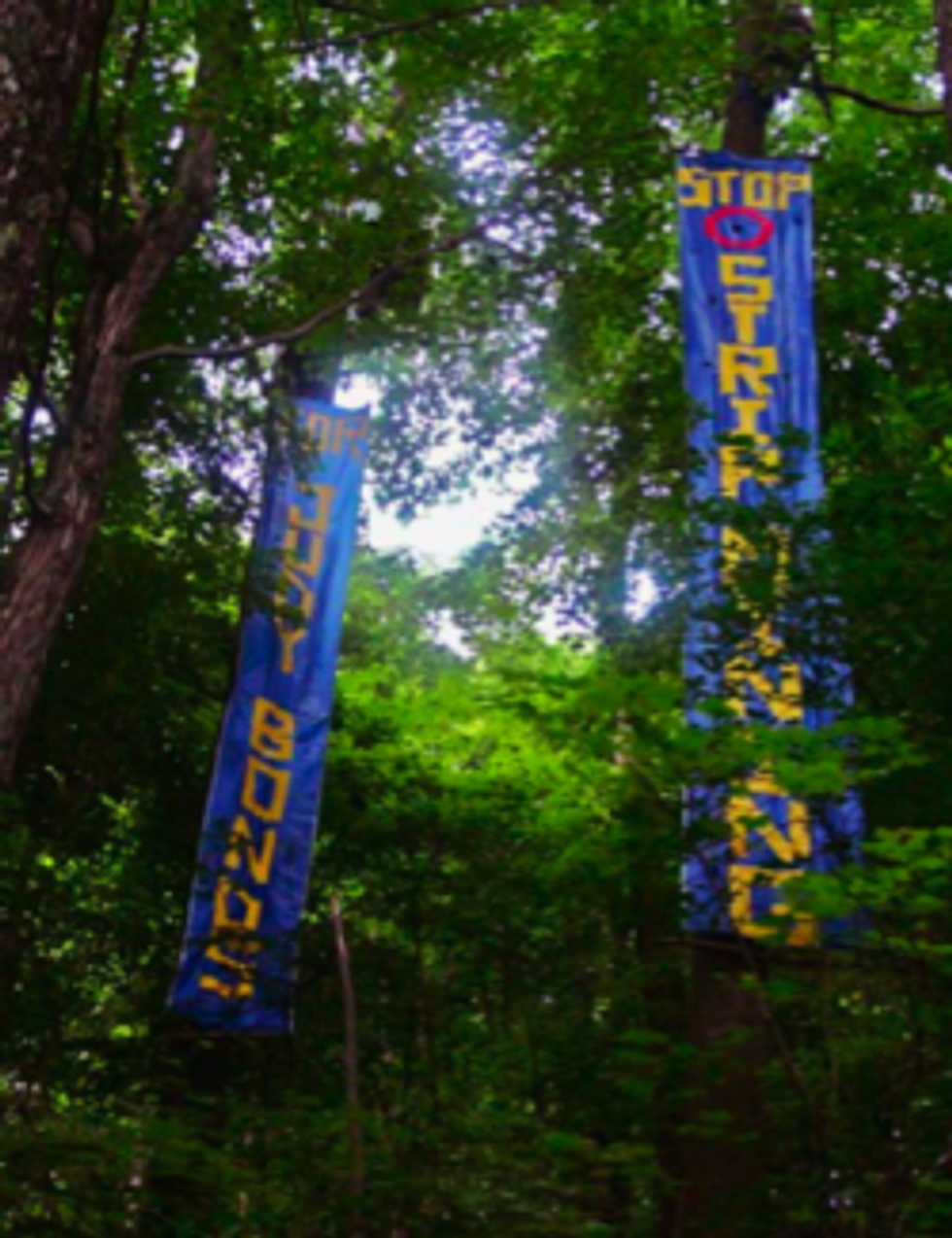For Judy Bonds: Historic Tree-Sit on Coal River Mountain Enters 10th Day
Appalachian leader Judy Bonds would have turned 59-years-old on August 27th. Since the passing of the 2003 Goldman Prize-winning hero from Coal River Valley in West Virginia in January, devastating mountaintop removal operations have continued to destroy her beloved Coal River Mountain.

Perched 80-feet high on wooden platforms in the great deciduous forests in the heart of the Bee Tree strip mine site, two women with the RAMPS campaign have entered the 10th day in their historic tree-sit protest to halt the blasting on Coal River Mountain. Being hailed as the longest tree-sit in the area, Becks Kolins, 21, and Catherine-Ann MacDougal, 24, have effectively stalled strip mining operations and forced out-of-state Alpha Natural Resources-who took over the controversial mine site from Massey Energy-to recognize local concerns and the spiraling humanitarian crisis from mountaintop removal mining.
"The tree sitters have for 10 days now halted blasting at the Bee Tree site," Coal River Mountain Watch Executive Director Vernon Haltom said. "This is 10 days reduced danger of catastrophe from blasting next to the Brushy Fork sludge dam. This is 10 days less toxic blasting fallout for residents to breathe, and less danger from cancer. The tree sitters are providing a valuable service by protecting the community, and for that I appreciate their effort. Judy Bonds would be proud."
The tree-sitters have dropped two banners from their platforms: STOP STRIP MINING and FOR JUDY BONDS.
Tree-sitter MacDougal has cited the health and environmental damages from mountaintop removal areas. In an open statement, she noted:
There is no way that I can begin to detail the comprehensive destruction that surface mining and mountaintop removal wreak on the forest ecosystem of the southern Appalachian mountains. Valley fills choke ephemeral, intermittent, and other headwater streams, eliminating their function in providing organic matter downstream, increasing the sediment load, and causing flooding. Sulfuric acid released during mining leaches heavy metals that poison aquatic life and humans. The forests that are clear-cut before a mountaintop is destroyed cannot begin to grow back on a reclaimed site; the geology, hydrology, topography, substrate, and chemistry of a strip mined site cannot be manipulated to resemble those of the original forest, making reclamation an empty promise2. The soils will take a century to recover, and the mountain itself will be gone forever.
Research has demonstrated these environmental impacts and many more, but those who are drinking tainted water, breathing coal dust, and watching the mountains fall around them don't need a scientific study to tell them what's wrong.
Since the first swaths of forests were cleared by bulldozers in the fall of 2009, mountaintop removal activists across the country have drawn a line in the sand at the Bee Tree site on Coal River Mountain as the ultimate battleground to stop mountaintop removal and launch a just transition for clean energy production and jobs. The Bee Tree operation, in particular, bulldozed the local community's hopes for a Coal River Wind Project that would have provided more tax revenues, energy production and long-term jobs.
While Appalachian leaders call on the Obama administration to enact an immediate mountaintop removal moratorium until the federal government can effectively mitigate a spiraling humanitarian crisis, local residents are urging everyone to send in comments on the mine's renewal permit by August 9th.
To support the tree-sitters RAMPS campaign, you can follow them on twitter or here.
An Urgent Message From Our Co-Founder
Dear Common Dreams reader, The U.S. is on a fast track to authoritarianism like nothing I've ever seen. Meanwhile, corporate news outlets are utterly capitulating to Trump, twisting their coverage to avoid drawing his ire while lining up to stuff cash in his pockets. That's why I believe that Common Dreams is doing the best and most consequential reporting that we've ever done. Our small but mighty team is a progressive reporting powerhouse, covering the news every day that the corporate media never will. Our mission has always been simple: To inform. To inspire. And to ignite change for the common good. Now here's the key piece that I want all our readers to understand: None of this would be possible without your financial support. That's not just some fundraising cliche. It's the absolute and literal truth. We don't accept corporate advertising and never will. We don't have a paywall because we don't think people should be blocked from critical news based on their ability to pay. Everything we do is funded by the donations of readers like you. Will you donate now to help power the nonprofit, independent reporting of Common Dreams? Thank you for being a vital member of our community. Together, we can keep independent journalism alive when it’s needed most. - Craig Brown, Co-founder |
Appalachian leader Judy Bonds would have turned 59-years-old on August 27th. Since the passing of the 2003 Goldman Prize-winning hero from Coal River Valley in West Virginia in January, devastating mountaintop removal operations have continued to destroy her beloved Coal River Mountain.

Perched 80-feet high on wooden platforms in the great deciduous forests in the heart of the Bee Tree strip mine site, two women with the RAMPS campaign have entered the 10th day in their historic tree-sit protest to halt the blasting on Coal River Mountain. Being hailed as the longest tree-sit in the area, Becks Kolins, 21, and Catherine-Ann MacDougal, 24, have effectively stalled strip mining operations and forced out-of-state Alpha Natural Resources-who took over the controversial mine site from Massey Energy-to recognize local concerns and the spiraling humanitarian crisis from mountaintop removal mining.
"The tree sitters have for 10 days now halted blasting at the Bee Tree site," Coal River Mountain Watch Executive Director Vernon Haltom said. "This is 10 days reduced danger of catastrophe from blasting next to the Brushy Fork sludge dam. This is 10 days less toxic blasting fallout for residents to breathe, and less danger from cancer. The tree sitters are providing a valuable service by protecting the community, and for that I appreciate their effort. Judy Bonds would be proud."
The tree-sitters have dropped two banners from their platforms: STOP STRIP MINING and FOR JUDY BONDS.
Tree-sitter MacDougal has cited the health and environmental damages from mountaintop removal areas. In an open statement, she noted:
There is no way that I can begin to detail the comprehensive destruction that surface mining and mountaintop removal wreak on the forest ecosystem of the southern Appalachian mountains. Valley fills choke ephemeral, intermittent, and other headwater streams, eliminating their function in providing organic matter downstream, increasing the sediment load, and causing flooding. Sulfuric acid released during mining leaches heavy metals that poison aquatic life and humans. The forests that are clear-cut before a mountaintop is destroyed cannot begin to grow back on a reclaimed site; the geology, hydrology, topography, substrate, and chemistry of a strip mined site cannot be manipulated to resemble those of the original forest, making reclamation an empty promise2. The soils will take a century to recover, and the mountain itself will be gone forever.
Research has demonstrated these environmental impacts and many more, but those who are drinking tainted water, breathing coal dust, and watching the mountains fall around them don't need a scientific study to tell them what's wrong.
Since the first swaths of forests were cleared by bulldozers in the fall of 2009, mountaintop removal activists across the country have drawn a line in the sand at the Bee Tree site on Coal River Mountain as the ultimate battleground to stop mountaintop removal and launch a just transition for clean energy production and jobs. The Bee Tree operation, in particular, bulldozed the local community's hopes for a Coal River Wind Project that would have provided more tax revenues, energy production and long-term jobs.
While Appalachian leaders call on the Obama administration to enact an immediate mountaintop removal moratorium until the federal government can effectively mitigate a spiraling humanitarian crisis, local residents are urging everyone to send in comments on the mine's renewal permit by August 9th.
To support the tree-sitters RAMPS campaign, you can follow them on twitter or here.
Appalachian leader Judy Bonds would have turned 59-years-old on August 27th. Since the passing of the 2003 Goldman Prize-winning hero from Coal River Valley in West Virginia in January, devastating mountaintop removal operations have continued to destroy her beloved Coal River Mountain.

Perched 80-feet high on wooden platforms in the great deciduous forests in the heart of the Bee Tree strip mine site, two women with the RAMPS campaign have entered the 10th day in their historic tree-sit protest to halt the blasting on Coal River Mountain. Being hailed as the longest tree-sit in the area, Becks Kolins, 21, and Catherine-Ann MacDougal, 24, have effectively stalled strip mining operations and forced out-of-state Alpha Natural Resources-who took over the controversial mine site from Massey Energy-to recognize local concerns and the spiraling humanitarian crisis from mountaintop removal mining.
"The tree sitters have for 10 days now halted blasting at the Bee Tree site," Coal River Mountain Watch Executive Director Vernon Haltom said. "This is 10 days reduced danger of catastrophe from blasting next to the Brushy Fork sludge dam. This is 10 days less toxic blasting fallout for residents to breathe, and less danger from cancer. The tree sitters are providing a valuable service by protecting the community, and for that I appreciate their effort. Judy Bonds would be proud."
The tree-sitters have dropped two banners from their platforms: STOP STRIP MINING and FOR JUDY BONDS.
Tree-sitter MacDougal has cited the health and environmental damages from mountaintop removal areas. In an open statement, she noted:
There is no way that I can begin to detail the comprehensive destruction that surface mining and mountaintop removal wreak on the forest ecosystem of the southern Appalachian mountains. Valley fills choke ephemeral, intermittent, and other headwater streams, eliminating their function in providing organic matter downstream, increasing the sediment load, and causing flooding. Sulfuric acid released during mining leaches heavy metals that poison aquatic life and humans. The forests that are clear-cut before a mountaintop is destroyed cannot begin to grow back on a reclaimed site; the geology, hydrology, topography, substrate, and chemistry of a strip mined site cannot be manipulated to resemble those of the original forest, making reclamation an empty promise2. The soils will take a century to recover, and the mountain itself will be gone forever.
Research has demonstrated these environmental impacts and many more, but those who are drinking tainted water, breathing coal dust, and watching the mountains fall around them don't need a scientific study to tell them what's wrong.
Since the first swaths of forests were cleared by bulldozers in the fall of 2009, mountaintop removal activists across the country have drawn a line in the sand at the Bee Tree site on Coal River Mountain as the ultimate battleground to stop mountaintop removal and launch a just transition for clean energy production and jobs. The Bee Tree operation, in particular, bulldozed the local community's hopes for a Coal River Wind Project that would have provided more tax revenues, energy production and long-term jobs.
While Appalachian leaders call on the Obama administration to enact an immediate mountaintop removal moratorium until the federal government can effectively mitigate a spiraling humanitarian crisis, local residents are urging everyone to send in comments on the mine's renewal permit by August 9th.
To support the tree-sitters RAMPS campaign, you can follow them on twitter or here.

